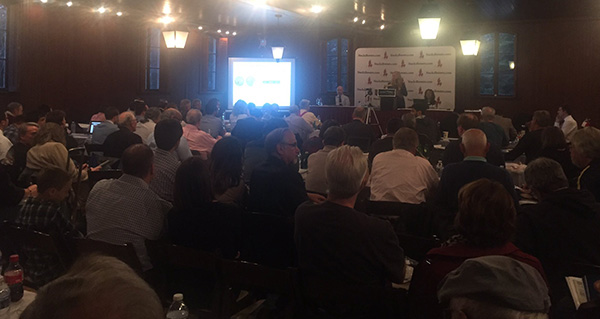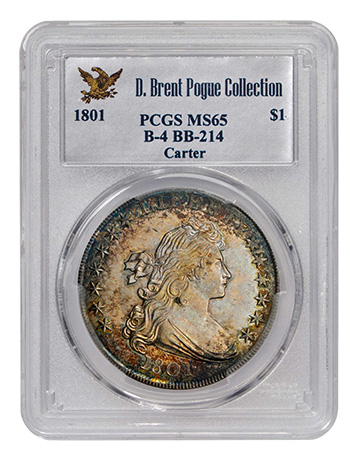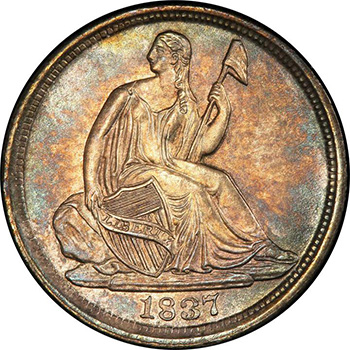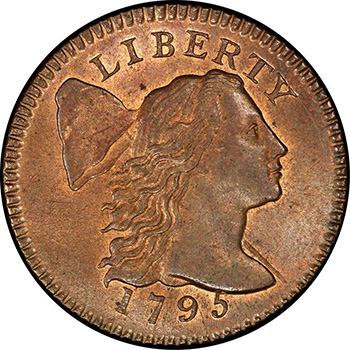Coin Rarities & Related Topics: News and Analysis regarding scarce coins, markets, and coin collecting #377
A Weekly CoinWeek Column by Greg Reynolds …..
The Pogue V sale by Stack’s-Bowers was held the evening of Friday, March 31 at the Evergreen House, the former residence of the Garrett Family Coin Collection. This auction was enormously successful, with relatively high-grade type coins faring particularly well. The most newsworthy aspects were strong to extremely strong prices for many large cents, really startling results.
The event was conducted in association with Sotheby’s and with the involvement of a local auction firm in Maryland. Stack’s-Bowers also conducted the official auction of the Whitman Coin Expo at the Baltimore Convention Center during last week. The prices realized at the Pogue sale, however, were certainly stronger than the prices realized in the other auction sessions. If some of the same large cents had been offered, without any mention of pedigrees, a day earlier or a day later in auction sessions at the convention center, the prices realized would not have been nearly as high, in my estimation.
The Pogue V sale “beat the market”! This was a shining event in a generally lackluster market climate. Volume has been higher over the last several months than it was during much of 2016. Prices generally are not much different; some are higher than they were in 2016 while other market levels are lower.

Demand really is not greater than it was in 2016. The increase in volume was more a function of collectors buying more coins privately at current price levels. Dealers had been inventorying many of the rarities that emerged from 2013 to 2016 when an unusually large number of excellent and extensive collections were auctioned: Cardinal large cents and other early rarities in January 2013, the Greensboro Collection mostly from 2013 to 2015, the Eric P. Newman Collection mostly in 2013 and 2014, the Gardner Collection in 2014 and 2015, Mervis large cents in January 2015, the first four Pogue events in 2015 and 2016, etc.
Of course, excellent coin collections are auctioned every year. The number and depth of collections offered that are very much relevant to the Pogue sales, however, was tremendous from 2013 to 2015. Over the last seven months, the supply of rarities in inventories and in auctions has fallen, as the vast majority of the coins in many of the collections that came to market from 2013 to 2016 have finally been disbursed into private collections throughout the nation.
A new player who has spent more than $50 million since last year has contributed to demand for many rarities, though even an injection of $100 million would not make that much difference. Literally, billions of dollars of coins are sold ever year. Also, while there are new entrants, others are exiting.
Demand has been around the same, while supplies have varied. The supply of rarities available, at auction or privately, trended at high levels from 2012 to 2016.
“Market levels for scarce, CAC-stickered coins have remained about the same so far in 2017,” John Albanese reports. Albanese is the founder and president of Certified Acceptance Corporation (CAC).
Many collectors became energized about this one auction, the last of a string of Pogue sales and one of the all-time greatest offerings of high-grade large cents – possibly the best in generations to be sold at auction.
“Other than the 1804 dollar, the coins in the Pogue V sale tended to bring every penny of their value and then some,” author Scott Travers declares.

The $3,290,000 result for the 1804 dollar is receiving a disproportionate amount of media attention. The price realized and the coin itself are not representative of the Pogue V sale. Moreover, to understand the price realized, there is a need to analyze the physical characteristics of this coin, an undertaking that is best left to a separate discussion of 1804 dollars in general.
Kevin Lipton and John Albanese purchased this 1804 silver dollar for inventory. I am not commenting on the strength or weakness of this auction result here.
As discussed in Part 21 of this series, the Pogue V sale will be best remembered for one of the all-time greatest sets of large cents and for an impressive run of 19th-century half cents. The Carter-Pogue 1801 and Eliasberg-Pogue 1802 silver dollars clearly captured the hearts and minds of bidders.
It seems that the Carter-Pogue coin and the Earle-Newman-Morelan coin are the two finest 1801 silver dollars, without consideration of Proof “1801” silver dollars that were struck decades later. The Newman 1801 was NGC-graded as MS-65 when it was auctioned in November 2013. Jim McGuigan, Richard Burdick and I were all enthusiastic about it.
Bruce Morelan had the Newman 1801 dollar crossed into a PCGS holder for entry into his PCGS registry set of early dollars, which includes the $10 million 1794. His whole set was on display at the FUN Convention in Fort Lauderdale.
In terms of precise grade, the Newman and Carter-Pogue coins are about the same, give or take a small fraction of a grade-increment. The Carter 1801, however, is incredibly exciting. Some scratches are offset by glorious colors and pizazz. Stack’s (NY) auctioned the Amon Carter Collection in January 1984.
Before discussing the obverse, it makes sense to focus on the reverse of the Carter-Pogue 1801 dollar.
Other than that on the Carter-Knoxville-Cardinal 1794, this is the most exciting reverse I have ever seen on an early dollar. It exhibits full strong mirrors, including mirrors within the shield. The toning is astonishing. A blue and russet eagle contrasts with terrific green colors nearby. There is also notable orange toning in the reverse outer fields and elsewhere. The colors, mirrors and entertaining die finishing lines on the reverse altogether bring about a unique and forever memorable viewing experience. Although the obverse of the Carter-Pogue 1801 is not nearly as prooflike as the reverse, the obverse is lively and very colorful.
The Newman 1801 brought $329,000 in November 2013, in an auction characterized by innumerable very strong prices and much maniacal bidding. Furthermore, market levels overall were higher in November 2013 than in March 2017. Even so, there is something magical about the Carter-Pogue 1801. I have never seen another Heraldic Eagle silver dollar that resembles it or has equivalent energy. A collector bought it for nearly $400,000.

Bidding wars for both the Carter-Pogue 1801 and the Eliasberg-Pogue 1802 were unsurprising. The final price for the Eliasberg-Pogue 1802, however, was surprising. I figured that $265,000 would be a very strong price. It brought $329,000!
The Eliasberg-Pogue 1802 silver dollar is one of six for the design type that are CAC-approved at the MS-65 level, though the only 1802. Someone who is building a highest quality practical, CAC-only set of bust dollars might have felt compelled to pursue this coin. It is curious, though, that PCGS reports four having been graded as MS-65 and an 1802 as grading “MS-65+”!
Not one price guide estimate, past auction price or private transaction known to me is in line with a price realized of more than $300,000 for the Eliasberg-Pogue 1802. Perhaps the most relevant result is the $247,250 realization for a different PCGS-graded MS-65 1802 in June 2005. ANR then auctioned the Cardinal Collection of early dollars in New York, an event that I covered for Numismatic News newspaper.
Besides, bidders at the Cardinal silver dollar sale in 2005 probably then assumed that the Pogue 1802 would not become available for decades, if they knew about the Pogue 1802 at all.
This same Clapp-Eliasberg-Pogue 1802 realized $165,000 in April 1997, a very strong price at the time, though this would have been a weak price in 2017. A price realized now in the $200,000 to $250,000 range would not have been newsworthy. The $329,000 price may relate to the extent to which people will pay for the highest PCGS-graded coins for PCGS registry sets.
There are currently multiple, serious competitors in the field of type sets, in the PCGS registry and in unregistered sets that follow PCGS outlines for set composition.
MS-67 1837 Half Dimes

The Pogue V sale started with strength when both the PCGS-graded MS-67 1837 half dimes went for sizable retail prices. The ‘Large Date’ brought an astounding price of $29,375. Values in all the price guides were surpassed, including the PCGS guide value of $20,000, the NGC guide value of $20,500 and the Numismedia retail estimate of $13,980. This coin has been approved at CAC, and the Numismedia CAC estimate for this coin is or recently was “$17,500.”
Although my research often suggests that many values listed in price guides are inaccurate, my impression is that the major guides are largely correct in regard to the current values of gem quality 1837 Liberty Seated half dimes.
The Pogue 1837 “Small Date” is a much more appealing coin in my view, and it brought less than the PCGS-graded MS-67 ‘Large Date’ 1837, though the $28,200 result is also a newsworthy amount. Even $20,000 would have been a retail price. This ‘Small Date’ 1837 has been CAC-approved as well. The Numismedia CAC value estimate is “$23,000”, which is significantly higher than the regular Numismedia “retail” estimate of “$19,830”.
During 2013, Heritage auctioned two PCGS-graded MS-67 “Small Date’ 1837 dimes for $23,000 and $16,450, respectively. In January 2005, this same Pogue piece, which was then part of the epic James Lull type set, brought $25,300 at an auction in Fort Lauderdale. Market values for gem Liberty Seated coins were higher in 2005 than they are presently.
This 1837 ‘Small Date’ half dime has fabulous green hues, along with neat russet and orange-russet tints. Additionally, the luster is full and rich. This is a great coin.
Although the Liberty Seated coins fared well in this auction, the major story is the prices realized for the large cents. A couple of half cents, though, should be mentioned.
Famous Tettenhorst-Missouri-Pogue 1811 Half Cent
On January 26, 2014, the Goldbergs auctioned the all-time greatest set of half cents, the Tettenhorst-Missouri Cabinet. The most surprisingly high result in that sale was $1.12 million for an 1811 half cent. Although this coin was PCGS-certified as ‘MS-66RB’ and CAC-approved, an 1811 half cent had probably never before sold at auction for as much as $50,000.
While retail prices are logically above wholesale prices, a dealer-buy price for this coin in January 2014 would have been less than one-third of that price–$350,000 at most. Ever since the announcement in June 2014 that the Pogue Family Coin Collection would be auctioned, there has been speculation that this 1811 half cent would never again realize as much as $500,000.
One half cent expert told me last year that this coin might not even realize $400,000.
Although market levels have fallen considerably since the Tettenhorst-Pogue 1811 half cent realized $1.12 million in January 2014, this 1811 brought just about $1 million – $998,750 on Friday! Collectors who have actually seen the coin under proper lighting might have a better understanding than most collectors as to why multiple prospective buyers assign such a high value to this coin.
This 1811 half cent is truly superb. From a technical standpoint, it is almost flawless. The imperfections are too minor to mention in an auction review. If it had much more original mint red, it would easily grade 67! The fiery red hues about the letters of LIBERTY and the numerals of the ‘date’ are dramatic and exciting. This is one of the coolest of all early (pre-1840) U.S. coins.
Large Cents
It is not practical to cover all the large cents that sold. Therefore, some newsworthy prices and key dates are being discussed. The offering of large cents started with thunder when two of three Liberty Cap cents realized prices that were substantially higher than the exact same coins realized during time periods when market levels were higher than they are currently. No one I know expected many coppers in this sale to approach recent auction results for the exact same coins, especially not for these 1793 Liberty Cap cents.
The Husak 1793 set an auction record for a large cent when it sold for $632,500 on February 15, 2008. This was considered an extremely strong price at the time. It was then PCGS-graded as AU-55 and it has since been upgraded by PCGS to “AU-58.” It never had a CAC sticker. The gray colors and the serious imperfections near the numeral ‘1’ in the date serve to identify this coin. At the Pogue V sale Friday night, this Husak-Pogue 1793 went for $940,000, one of the strongest prices in the auction.
I am on record, in two different past articles, as having raved about the Boka-Cardinal-Pogue 1793 Liberty Cap large cent, which was PCGS-graded as AU-53 and is now PCGS-graded as AU-55. In September 2011, the Boka-Cardinal 1793 Liberty Cap was auctioned for $253,000. In January 2013, this same coin realized $282,000.
This Boka-Cardinal 1793 Liberty was CAC-approved at the AU-53 level and recently passed at CAC again after being upgraded to AU-55. The $376,000 result on March 31, 2017 may have been higher than anyone expected, though it is understandable. This coin is exceptionally attractive and relatively more original than several of the other high-grade 1793 Liberty Cap cents that survive.
The third 1793 Liberty Cap cent in the Pogue Collection is the Jay-Holmes coin, which distinguishes itself as being of a rarer die variety (S-14). It exhibits a prominent and long line from a bisecting die crack on the obverse. This coin was PCGS-graded AU-53 when the Goldbergs auctioned Dan Holmes’ early date large cents in September 2009. PCGS has since added a plus to this grade, “53+”.
The Jay-Holmes 1793 Liberty Cap coin sold for $506,000 in 2009 and brought just $235,000 on Friday. This coin would really be more of interest to large cent specialists than to collectors assembling type sets listed in the PCGS registry. There are many imperfections that require explanations. Indeed, this coin has imperfections that are not very bothersome in the minds of veteran copper specialists, yet may be irritating to collectors who are assembling type sets in all metals.
In addition to the three just mentioned 1793 Liberty Cap cents in this one auction (two S-13 and one S-14), a PCGS-graded AU-53 (S-13) 1793 Liberty Cap sold privately earlier in March at the ANA winter convention in Orlando. There have thus been an astonishing number of highly certified, 1793 Liberty Cap cents available. Only one uncirculated 1793 Liberty Cap cent is known – the Eliasberg coin in the “High Desert Collection”. Even VF-35 is considered a very high grade for a 1793 Liberty Cap cent.

Builders of type sets were also very interested in the Jackman-Jung 1794 ‘Apple Cheek’ cent. The Apple Cheek variety, however appealing, is beside the point that this is one of the highest certified large cents of the Liberty Cap design type. It is one of only two that are PCGS-certified as “MS-67RB”. Regardless of opinions about the coin, the addition of this coin to a type set in the PCGS registry would bring about registry points for the owner and provide an edge over others who have registered or will register, pertinent type sets on the PCGS web site.
Additionally, it is indisputable that the Jackman-Jung ‘Apple Cheek’ is one of the most technically impressive of all early large cents. There are almost zero contact marks and hairlines. The design detail is extraordinary as well.
The Jackman-Jung 1794 ‘Apple Cheek’ was previously part of two collection assembled by Oliver Jung. In the ANR auction of Oliver Jung’s type set in New York on July 23, 2004, this same large cent realized $126,500. When Jung’s second set was offered by Heritage in August 2014, this same coin sold for $352,500. This time, it brought $446,500!
One of my favorite coins in this sale was the Oswald-Naftzger-Foxfire-Pogue 1794 ‘Head of 1795’ cent, which is PCGS-certified as ‘MS-65RB’ and CAC-approved. The obverse is more than 25% original mint red, and the whole coin rates amazingly high in the category of originality. I certainly was not surprised that the auction result surpassed price guide levels, including $70,800 CDN retail, $115,000 NGC, and $140,000 PCGS. The $282,000 result is one of the more newsworthy prices in this auction.

The price realized for the Pogue 1795 Lettered Edge cent was not as much of a surprise, though still extremely strong. It is PCGS-certified as ‘MS-65+RB’ and has been approved at CAC. Scott Travers remarks that it is “all there as a 65+ Red & Brown coin.” Although the amount of mint red is not overwhelming in my view, this coin scores incredibly high in the categories of originality and eye appeal.
In comparison, the Naftzger-Parrino-Husak 1795 S-75 Lettered Edge cent is PCGS-certified as ‘MS-65RB’. That coin brought $207,000 in February 2008, a strong price when pertinent markets were peaking or nearly peaking. This coin is better, though current markets are nowhere near the levels that prevailed in February 2008. Even so, this coin sold for $223,250, an extremely strong price. It is a wonderful coin.
The queen of Liberty Cap large cents was in this sale, though I seem to be the only one who is publicly talking about it. I discussed this coin at length in an article in 2008 and to a significant extent in my already-cited recent article, Part 21 of this series. This 1796 Liberty Cap is one of my favorite of all large cents, ever since I was mesmerized by it in 2008. The upgrade from 66, a grade assigned in 2008 before plus grades were introduced in 2010, to “66+” cannot be controversial. Bright original red areas blend naturally with red areas that are fading to various degrees, making it difficult to estimate a percentage of original red. Nonetheless, there is clearly more than enough true red for an “RB” designation. The extent of surviving original mint red on this coin is amazing. The whole coin is superb.
When this 1796 Liberty Cap cent sold for $690,000 in September 2008, observers were stunned. This realization was then an auction record for any large cent. On March 31, 2017, it brought even more: $705,000! For a type set, this may be the ultimate Liberty Cap cent.
The 1823 is one of the key dates in the series of Matron Head cents. At the Goldbergs sale of Naftzger’s middle date cents in February 2009, the Pogues, with the assistance of Richard Burdick, bought two Naftzger 1823 cents; the first was PCGS-graded as MS-66 and the second was PCGS-graded as MS-65, a grade that has been raised to ‘65+.’ Both have been CAC-approved.
The prices realized then were $299,000 and $126,500, respectively, mind boggling at the time. Both 1823 cents actually realized more in 2017 than they did in 2009: $376,000 and $129,250, respectively. In this case, the more expensive coin really is much better, certainly it rates much higher in the technical and originality categories.
The 1839/6 is another key ‘middle date’. Again, the Pogues bought the finest-known Naftzger piece in February 2009, with the assistance of Richard Burdick. The Naftzger-Pogue 1839/6 was PCGS-graded a MS-65 and has later been upgraded to ‘65+’. It is CAC-approved. This coin sold for $264,500 in 2009 and $376,000 in 2017.
The Pogue V sale provides evidence that the era of single-consignor auction sessions of great collections is not over. Moreover, the Pogue V sale shows that an auction session may take on a life of its own, partly independent of current market realities. When particular auction factors intermesh and positively synergize in a way that is not entirely explainable, many auction participants will bid much more aggressively for coins than they would for the same coins in other settings.
© 2017 Greg Reynolds
PCGS-Certified Large Cents Currently Available on eBay
[wpebayads]





Thanks for the information about old coins!